Biology MCQs with answers for NEET Microbes in Human Welfare Miscellaneous
Question 1. The branch of biology which deals with the study of microbes is called
- Palynology
- Zoology
- Microbiology
- Botany
Answer: 3. Microbiology
Microbiology is the study of microbes or microorganisms, those being unicellular, multicellular or acellular. It encompasses numerous sub-disciplines including virology, parasitology, mycology and bacteriology.
Question 2. Which of the following microorganism is present in hot springs?
- Thermoplasma
- Halobacterium
- B. Brevis
- A. Niger
Answer: 1. Thermoplasma
Thermophilic microorganisms found in hot springs, e.g. Bacterium, thermoplastic.
Read And Learn More: NEET Biology Multiple Choice Question And Answers
Question 3. The energy obtained from biological resources is called
- Electrical energy Rajasthan
- Mechanical energy
- Bioenergy
- Life energy
Answer: 3. Bioenergy
Energy obtained from biological sources is called bioenergy, which is of two types, i.e. Animal energy and biofuels.
Biology MCQs with answers for NEET
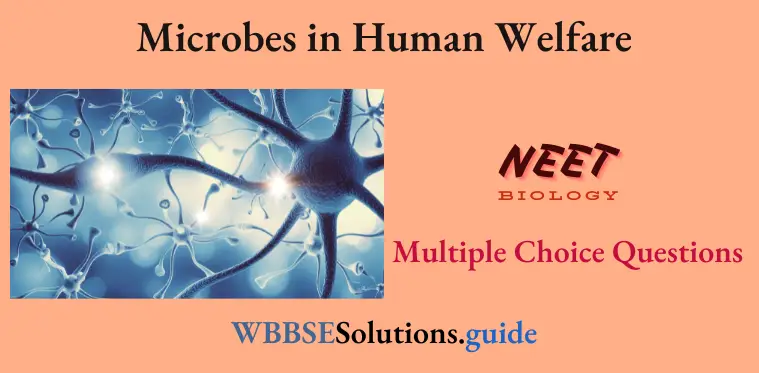
NEET Biology Microbes in Human Welfare MCQs with answers
Question 4. The botanical name of berseem (Egyptian clover) is
- Lens esculent
- Crotalaria juncea
- Cyamopsis tetragonoloba
- Trifolium alexandrinum
Answer: 4. Trifolium alexandrinum
The botanical name of berseem is Trifolium alexandrinum which is an annual clover, cultivated mostly in irrigated sub-tropical regions and used as fodder, mainly for cattle and milk buffalo.
“microbes in human welfare “
Question 5. Fill up the blanks.
- Bread making – A
- Commercial production of citric acid – B
- The traditional drink of South India – C
- Gives the characteristic feature of Swiss-cheesed
Choose the correct option
- A–penicillium roqueforti, B–penicillium, C– toddy, d–aspergillus niger
- A–lactobacillus, B–aspergillus niger, C–Toddy, D–acetobacter acetic
- A–Saccharomyces cerevisiae, B–aspergillus niger, C–Toddy, D–propionibacterium shermanii
- A–propionibacterium shermanii, B– bacillus, C–toddy, D–lactobacillus
Answer: 3. A–Saccharomyces cerevisiae, B–aspergillus niger, C–Toddy, D–propionibacterium shermanii
Important MCQs on Microbes in Human Welfare for NEET
Question 6. …… Are not nitrogen-fixing bacteria.
- Nostoc, clostridium and azotobacter
- Anabaena, azotobacter and rhizobium
- Nitrosomonas, nitrosococcus and nitrobacter
- Aulosira and bacillus polymyxis
Answer: 3. Nitrosomonas, nitroso-coccus and Nitrobacter
The conversion of ammonia to nitrite and nitrite to nitrate is carried out by certain bacteria in the soil. The chemosynthetic bacteria nitrosomonas, nitrobacter and nitrosococcus carry out denitrification. So, they are not nitrogen-fixing bacteria.
Biology MCQs with answers for NEET
Question 7. Match the following columns.
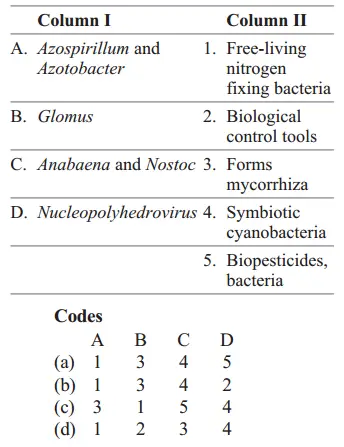
Answer: 2. A–1, b–3, c–4, d–2
Question 8. Match the following columns.
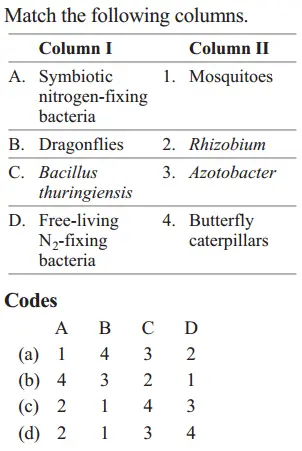
Answer: 3. A–2, b–1, c–4, d–3
“select the correct group of biocontrol agents “
Question 9. Which of the following is wrongly matched in the given table?
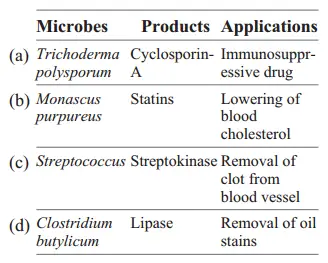
Answer: 4. Wrongly matched
Pair and can be corrected as clostridium bretylium is used for the production of butyric acid. Candida lipolytic is the source of lipase. Rest options are correctly matched pairs.
Biology MCQs with answers for NEET
Question 10. Edible fungus is
- Agaricus bisporus
- Volvariella volvacea
- Pleurotus Florida
- All of the above
Answer: 4. All of the above
All given species are edible fungi. Edible fungus is a nutritious food that can be consumed by human beings and other living organisms and does not cause any side effects. Thus, option
NEET quiz on Microbes in Human Welfare with solutions
Question 11. The calorific value of biogas is
- 10-20 MJ/kg
- 23-28 MJ/kg
- 30-40 MJ/kg
- 5-10 MJ/kg
Answer: 3. 30-40 MJ/kg
- Biogas is composed of gases such as CO2 (around 30%), ch4 (around 70%) and trace amounts of n2, o2 and water vapour.
- Its combustible portion is ch 4. Raw biogas has an average calorific value of about 30-35 MJ/kg. After purification, biogas can have a calorific value of 40-45mj/kg
Question 12. Assertion agriculture output increased several times after the introduction of DDT. Reason (R) DDT was the first insecticide used on a wide scale.
- Both a and r are true and r is the correct explanation of a
- Both a and r are true, but r is not the correct explanation of a
- A is true, but r is false
- Both a and r are false
Answer: 1. Both a and r are true and r is the correct explanation of a
Biology MCQs with answers for NEET
Question 13. In September 2001, which of the following was used as a bioweapon agent in America?
- Botulinum
- Anthrax (Bacillus anthracis)
- Poliovirus
- Aids virus
Answer: 2. Anthrax (Bacillus anthracis)
Question 14. Select the mismatch.
- Frankia – Alnus
- Rhodospirillum – mycorrhiza
- Anabaena – nitrogen-fixer
- Rhizobium – alfalfa
Answer: 2. Rhodospirillum – mycorrhiza
“an example of endomycorrhiza is “
Mismatched and can be corrected as rhodospirillum is an anaerobic, free-living bacterium that helps in nitrogen fixation. Whereas mycorrhiza is the symbiotic relationship between fungi and the roots of higher plants. The rest of the options are correctly matched pairs.
Question 15. Which of the following herbicides and defoliants were used by our military in its herbicidal warfare programme during the Vietnam War?
- Agent black
- Agent Orange
- Super orange
- Both (2) and (3)
Answer: 4. Both (2) and (3)
Agent Orange and Super Orange were used from 1961 to 1971. They released toxins, which caused harm to the health of those exposed during the Vietnam War. Agent blue and white were part of the same programme but did not contain toxins.
Question 16. Match the following columns and choose the correct option from the codes given below.
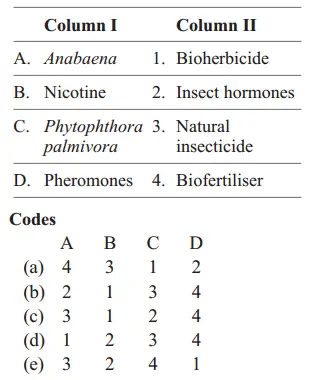
“microbes in human welfare neetprep “
Answer: 1. A–4, b–3, c–1, d–2
NEET expected MCQs on Microbes in Human Welfare 2025
Question 17. Match the following columns.
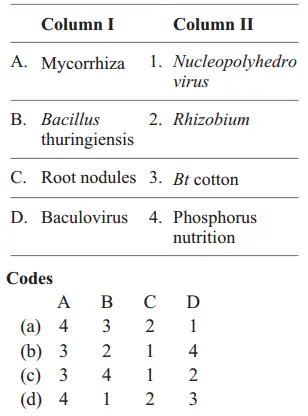
Answer: 1. A–4, b–3, c–2, d–1
